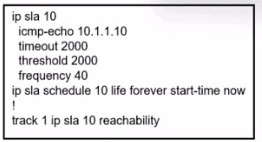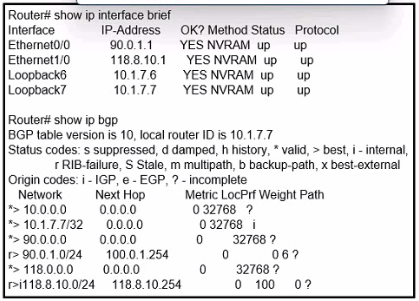Master Cisco 300-410 Exam with Reliable Practice Questions
Refer to the exhibit.

An engineer configured IP SLA to monitor a next hop on a router for reachability When the next hop is unreachable, the router is executing tracking and failing over another route, but packet loss is experienced because the reachability is flapping. Which action resolves the issue?
Correct : C
When the next hop is unreachable, the router is executing tracking and failing over to another route. However, packet loss is experienced because the reachability is flapping. This could be due to the router switching back and forth between the primary and backup routes too quickly.
Configure ISP Failover with Default Routes Using IP SLA Tracking - Cisco
Using IPSLA to change routing - Cisco Community
How to Use IP SLA Technology to Assess WAN Performance
Start a Discussions
The network administrator configured CoPP so that all SNMP traffic from Cisco Prime located at 192.168.1.11 toward the router CPU is limited to 1000 kbps. Any traffic that exceeds this limit must be dropped.
access-list 100 permit udp any any eq 161
!
class-map CM-SNMP
match access-group 100
!
policy-map PM-COPP
class CM-SNMP
police 1000 conform-action transmit
!
control-plane
service-policy input PM-COPP
The network administrator is not getting the desired result for the SNMP traffic and SNMP traffic is getting dropped frequently. Which set of configurations resolves the issue?
Correct : C
In the context of Control Plane Policing (CoPP) in Cisco devices, the rate limit is specified in bits per second (bps), not kilobits per second (kbps). Therefore, a limit of 1000 kbps should indeed be entered as 1,000,000 bps in the CoPP configuration.
Also, the access list should be configured to match the specific SNMP traffic from the Cisco Prime IP address (192.168.1.11), as you correctly pointed out.
Here's the corrected configuration:
no access-list 100
access-list 100 permit udp host 192.168.1.11 any eq 161
!
policy-map PM-COPP
class CM-SNMP
no police 1000 conform-action transmit
police 1000000 conform-action transmit
This configuration ensures that only the SNMP traffic from Cisco Prime is policed and any excess traffic is dropped, preventing the router's CPU from being overwhelmed.
Start a Discussions
Which Layer 3 VPN attribute allows different customers to connect to the same MPLS network wrth overlapping IP ranges?
Start a Discussions
Network engineer must configure an ElGRP stub router at a site that advertises only connected and summary routes. Which configuration performs this task?
A)

B)

C)

D)

Correct : B
The network engineer wants to configure an EIGRP stub router that advertises only connected and summary routes. This can be achieved with the configuration provided in Option B:
router eigrp 100
eigrp stub summary
Start a Discussions
Refer to the exhibit.

Which action adds the 10 1 7.6-32 route to the BGP table?
Correct : D
Start a Discussions